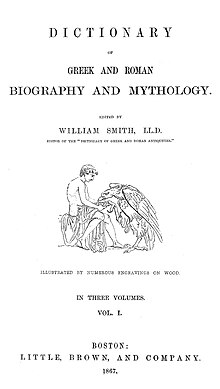Dictionary of Greek and Roman Biography and Mythology
 Title page of 1867 edition | |
| Author | William Smith |
|---|---|
Publication date | 1849 |
| Pages | 3,700 |
The Dictionary of Greek and Roman Biography and Mythology (1849, originally published 1844 under a slightly different title) is an encyclopedia/biographical dictionary. Edited by William Smith, the dictionary spans three volumes and 3,700 pages. It is a classic work of 19th-century lexicography. The work is a companion to Smith's Dictionary of Greek and Roman Antiquities and Dictionary of Greek and Roman Geography.[1]
Authors and scope[]

The work lists thirty-five authors in addition to the editor, who was also the author of the unsigned articles. The other authors were classical scholars, primarily from Oxford, Cambridge, Rugby School, and the University of Bonn, but some were from other institutions. Many of the mythological entries were the work of the German expatriate Leonhard Schmitz, who helped to popularise German classical scholarship in Britain.[2]
With respect to biographies, Smith intended to be comprehensive. In the preface, he writes:
The biographical articles in this work include the names of all persons of any importance which occur in the Greek and Roman writers, from the earliest times down to the extinction of the Western Empire in the year 476 of our era, and to the extinction of the Eastern Empire by the capture of Constantinople by the Turks in the year 1453.
Much of the value of the Dictionary consists not only in the depth and detail of the individual articles, but in the copious and specific citations to individual Greek and Roman writers, as well as modern scholarship from the Renaissance to the mid-nineteenth century. The articles frequently note variant traditions, disagreements among the authorities, and the interpretations of modern scholars. However, due to the variable numbering systems used in different editions of classical works, and the difficulty of recognizing typographical errors in citations, the original sources should still be checked. Many of the Dictionary's articles have been referred to in more recent works, and Robert Graves has been accused of "lifting his impressive-looking source references straight, and unchecked" from it when writing The Greek Myths.[2]
Samuel Sharpe thought Edward Bunbury had plagiarised his work, as he wrote of in his diary entry on 3 September 1850:
I certainly felt mortified on reading the articles on the Ptolemies in Dr. Smith's "Dictionary of Classical Biography." They were all written by E. H. Bunbury with the help of my "History of Egypt," and with-out any acknowledgment, though he even borrowed the volume from my brother Dan for the purpose.[3]
Use and availability today[]
The work is now in the public domain, and is available in several places on the Internet. While still largely accurate (only rarely have ancient texts been emended so severely as to warrant a biographical change), much is missing, especially more recent discoveries (such as Aristotle's Constitution of the Athenians, or the decipherment of Linear B) and epigraphic material. Perhaps more seriously, the context in which ancient evidence is viewed has often changed in the intervening century and a half.
See also[]
- Dictionary of Greek and Roman Antiquities
- Dictionary of Greek and Roman Geography
References[]
- ^ Chisholm, Hugh, ed. (1911). . Encyclopædia Britannica. Vol. 25 (11th ed.). Cambridge University Press. p. 270.
- ^ a b Nick Lowe (20 December 2005). "Killing the Graves myth". Times Online. London. Retrieved 2016-02-26.
- ^ Clayden, PW. Samuel Sharpe. p. 82. Retrieved 10 May 2016.
External links[]
| Wikimedia Commons has media related to The Dictionary of Greek and Roman Biography and Mythology. |
| Wikisource has original text related to this article: |
- Online version at the Perseus Digital Library
- Dictionary of Greek and Roman Biography and Mythology. Vol. I: Abaeus–Dysponteus online at University of Michigan Library.
- Dictionary of Greek and Roman Biography and Mythology. Vol. II: Earinus–Nyx online at University of Michigan Library.
- Dictionary of Greek and Roman Biography and Mythology. Vol. III: Oarses–Zygia online at University of Michigan Library.
Also the Internet Archive has a derivative work:
- Smith, William (1853). A new classical dictionary of biography, mythology, and geography, partly based on the "Dictionary of Greek and Roman biography and mythology.". London: Murray.
- Anthon, Charles; Smith, William (1860). A new classical dictionary of Greek and Roman biography, mythology and geography: partly based upon the Dictionary of Greek and Roman biography and mythology by William Smith (1860). New York: Harper and Brothers.
- 1849 books
- Biographical dictionaries by topic
- References on Greek mythology